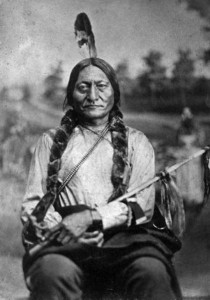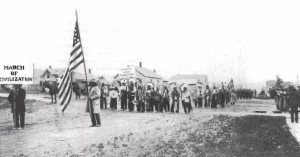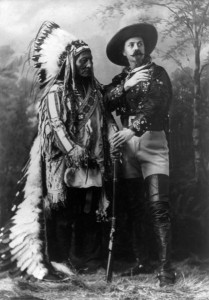 Was Chief Sitting Bull a Catholic convert? Did he convert William “Buffalo Bill” Cody? That was the scuttlebutt around Catholic circles this past week. From stories, to blogging, to Catholic radio shows, to postings from Facebook friends, I heard it multiple times.
Was Chief Sitting Bull a Catholic convert? Did he convert William “Buffalo Bill” Cody? That was the scuttlebutt around Catholic circles this past week. From stories, to blogging, to Catholic radio shows, to postings from Facebook friends, I heard it multiple times.
As a student of the Old West, having read numerous accounts of Sitting Bull and a resident of the once vast Dakota Territory, I thought it unlikely. But was it possible that Sitting Bull was a full member of the Catholic Church? To begin with, there are no baptismal records from Father Pierre De Smet, the most likely priest to have baptized him. And later, after Sitting Bull surrendered from Canada and then led a life as an autograph-seller, celebrity, and farmer on a shrunken reservation in Dakota Territory, it appears that even a bishop tried unsuccessfully to bring Chief Sitting Bull into the Catholic Church.
Historical records show that many of the Sioux, Chief Sitting Bull among them, admired the “black robes” as they called the Catholic missionary priests. The great Jesuit missionary, Father De Smet, was a friend of Chief Sitting Bull. There are multiple accounts in 1868 of Father De Smet walking, alone, unarmed, into an armed Sioux camp of five thousand. He helped to secure the numerous signatures of chiefs that appear on the 1868 Fort Laramie Treaty. General Stanley was quoted in 1868 as saying, “Father De Smet alone of the entire white race could penetrate to these cruel savages and return safe and sound.”
Sitting Bull or Tatanka Iyotake, his Lakota name, was born in 1831 near the Grand River in what is now South Dakota today. He was 37 years old by the time he encountered Father De Smet near present day Fort Rice, North Dakota to sign the Ft. Laramie Treaty of 1868. The Sioux people were divided into several bands and by that year, Sitting Bull was the leader of the Unkpapa band of Sioux or Lakota people. He was considered by the Unkpapa to be both a medicine man and a chief.
Father De Smet had possibly known Sitting Bull for 20 years by the time the two met near Fort Rice in 1868. In 1904 a history of South Dakota was put together by Doane Robinson. A section of the history of the Catholic Church was edited by the then Bishop of Sioux Falls, Thomas O’Gorman. Bishop O’Gorman wrote that Father De Smet, “has left a complete record of his visit made in the summer of 1848, but says he was impelled to make that visit by interest aroused during a ‘transient visit to some tribes of Sioux, on the upper Missouri, on my way back from the Rocky mountains.’”
That is likely when Father De Smet first met Sitting Bull. He would have been 17 years old and Father De Smet was 47 in 1848.
The practices of the Unkpapa, and the Lakota spiritual life were much different than what the men in the black robes tried to explain. Imagine Father De Smet explaining Jesus Christ, the Eucharist, and Heaven to a world that believed that each living thing had a spirit that was connected to the Great Spirit. Like most Lakota men, Sitting Bull would often go into a sweat lodge, and pierce himself, pass out, and have a vision to know what to do, or what was to befall him.
From 1848 to 1870 Father De Smet would have likely had multiple encounters with Sitting Bull. Although he possibly may have baptized Sitting Bull, there are no official records, only entries from Father De Smet of baptizing great numbers of Indians, but not their names. And when Father De Smet used names, he used French ones, perhaps even assigning them himself.
Sitting Bull is reported to have had as many as five wives. Wikipedia lists their names as Light Hair, Four Robes, Snow-on-Her, Seen-by-her-Nation and Scarlet Woman. A couple of wives died, and he eventually settled on two women. These were his companions until the end of his life.
This continued to be the major stumbling block to Sitting Bull’s entry into the Catholic Church. He would not give up his wives. That Sitting Bull liked family life, there can be no question. However, getting into the Church with two wives, that appeared to remain a “problem” throughout his life.
Battle of the Little Bighorn
Following the June 25, 1876, Battle of the Little Bighorn, or Greasy Grass (as the Indians call it), the U.S. Army chased Sitting Bull and his Unkpapa people (including women and children) through what is now Yellowstone. The U.S. demanded that Sitting Bull and the Unkpapa move back to the reservation designated for them in Dakota Territory. Sitting Bull wanted the U.S. to abide by the 1868 Ft. Laramie Treaty that Father De Smet helped broker. (Father De Smet had died three years before the Battle of the Little Bighorn, in 1873.) The vast Sioux Reservation in 1868 was roughly one-fourth its original size by 1874, and Sitting Bull was not a signer to that “treaty.” He wanted the freedom that had been granted him and his people in 1868.
The U.S. refused. So Sitting Bull and the Unkpapa fled north to Canada to stay with some of the other bands of Sioux north of the border. The one white person that Sitting Bull trusted to talk to in Canada was newly commissioned Father Martin Marty. In 1877, Father Marty spent eleven days with Sitting Bull trying to persuade him to return home.
Father Marty, born in 1834 in a tiny town in Switzerland, was 42 when he was sent by his Benedictine order to be the first permanent Catholic priest for the northwestern Dakota Territory. He established a mission on the Sioux Standing Rocking Agency (Ft. Yates), the same summer as the Battle of Greasy Grass. He prepared himself by writing a Sioux dictionary and translating Church documents into the Sioux language. He was known later as Bishop Marty, “The Apostle to the Sioux.”
After Father Marty met with Sitting Bull in Canada in 1877 he wrote letters to newspapers and to government leaders seeking a way for Sitting Bull and his followers to return. Finally, after four years in Canada, in 1881, Sitting Bull and about 200 Unkpapa surrendered to the U.S. Sitting Bull and his followers then spent nearly two years in prison at Fort Randall in what is now South Dakota (and where the present day Fort Randall dam is on the Missouri river).
Finally Sitting Bull was “freed” to travel to the Standing Rock Agency at Fort Yates in what is now North Dakota. This was just a few miles south of Fort Lincoln where, just seven years earlier, Colonel George Armstrong Custer and the Seventh Calvary left for Little Big Horn to meet their deaths.
 Later that year, 1883, Sitting Bull came across the railroad bridge to the new capital of Dakota Territory (D.T.), Bismarck, at this time a bustling town of 2,000 people. Bismarck was the site of an engineering marvel, the first bridge over the mighty Missouri River, taking the Northern Pacific Railroad into Montana and to the Pacific Coast. Earlier that year voters had chosen Bismarck over what was once the capital of D.T., Yankton, in what is now South Dakota. Bismarck was about to dedicate a new capitol building and Sitting Bull and other great chiefs were invited to Bismarck to join in the celebration for the “March of Civilization.”
Later that year, 1883, Sitting Bull came across the railroad bridge to the new capital of Dakota Territory (D.T.), Bismarck, at this time a bustling town of 2,000 people. Bismarck was the site of an engineering marvel, the first bridge over the mighty Missouri River, taking the Northern Pacific Railroad into Montana and to the Pacific Coast. Earlier that year voters had chosen Bismarck over what was once the capital of D.T., Yankton, in what is now South Dakota. Bismarck was about to dedicate a new capitol building and Sitting Bull and other great chiefs were invited to Bismarck to join in the celebration for the “March of Civilization.”
Sitting Bull was a celebrity in Bismarck. He walked into Barry Studios on Main St. and had some photos taken. Some of the most famous images you know of Sitting Bull came from the photo shoot that day in 1883. And he sold his autograph for $2 to make some money (that translates into about $100 in today’s dollars).
There was a Catholic Church in Bismarck, but there is no record that Sitting Bull attended services. Sitting Bull wanted to taste more of his celebrity and so he headed east on the new Northern Pacific Railroad.
His conversion into possibly becoming a Catholic makes a small headline in the New York Times from a story on September 27, 1883, “An unforeseen obstacle to his (Sitting Bull’s) reception has been met in the shape of two wives, neither of whom Sitting Bull can make up his mind to part with.” The article concludes, “Until the red man brings himself to put aside one or the other of his marital companions he will be debarred entrance.”
Thus, he still wasn’t a Catholic in late 1883 according to the NY Times article, which references Bishop Marty’s efforts to convert him as well: “[T]he famous warrior’s reception into the church, will be delayed for a time, it ever takes place. Sitting Bull is at Fort Yates where he has been under the instruction of Bishop Marty for a long time.”
With “Buffalo Bill” Cody
 Late that year (1883), Sitting Bull joined up with “Buffalo Bill’s Wild West”, (the word “show” was not a part of the title). This was, though, a show of shows. A version of the “Wild West” was staged from 1883 until 1907 all over the world before Presidents, Kings and Queens, and even Pope Leo XIII in 1890. “Buffalo Bill’s Wild West” was over the top entertainment for its time, and even by today’s standards. William Cody restaged the Battle of the Little Bighorn — back then it was called “Custer’s Last Stand.” And what a better draw than to have Sitting Bull Bull playing the part of massacring soldiers.
Late that year (1883), Sitting Bull joined up with “Buffalo Bill’s Wild West”, (the word “show” was not a part of the title). This was, though, a show of shows. A version of the “Wild West” was staged from 1883 until 1907 all over the world before Presidents, Kings and Queens, and even Pope Leo XIII in 1890. “Buffalo Bill’s Wild West” was over the top entertainment for its time, and even by today’s standards. William Cody restaged the Battle of the Little Bighorn — back then it was called “Custer’s Last Stand.” And what a better draw than to have Sitting Bull Bull playing the part of massacring soldiers.
After four months on the road, selling autographs and acting for Buffalo Bill, Sitting Bull wanted to go back to Fort Yates and the Standing Rock Agency. During those four months in 1884, whether he talked Buffalo Bill Cody into being Catholic is a matter of conjecture. Historical records from Iowa, where Cody was born, indicate that ‘Buffalo Bill’ was baptized in the Dixie Union Chapel in Peel County, Iowa in 1847. It was not until the day before he died that Cody became a Catholic.
According to three sources, Cody died at the age of 70 in Denver, Colorado surrounded by friends and family at his sister’s house in Denver. The day before Cody died on January 9, 1917, he was baptized into the Roman Catholic Church by Father Christopher Walsh of the Denver Cathedral of the Immaculate Conception. The following day January 10, 1917 William Cody reportedly died of kidney failure.
Final Days of Sitting Bull
Sitting Bull chose to return to the Standing Rock reservation and become a farmer in 1884. He was a family man who lived with his two wives, children and grandchildren. In 1888 and 1889 the U.S. government sent commissions seeking further concessions of land for white settlements. Since most of the other Sioux leaders were dead from the Indian wars, the government tried to get Sitting Bull to surrender more territory and shrink his people’s reservations even more. He refused. In 1888 he became a “boss-farmer” a leader of the other Unkpapa farmers at the agency. Then someone complained to the reservation’s Indian Agent at Fort Yates that Sitting Bull had two wives, in defiance of Agency’s rules (and the Church’s rules too, of course). The Agent had Sitting Bull relieved of his position as boss-farmer.
In 1880 Pope Leo XIII had consecrated Father Marty as the first Bishop of the Dakota Territory. Bishop Marty decided that Yankton, then the capital of D.T., would be the place for his diocesan headquarters. Sitting Bull likely saw Bishop Marty during his time at Standing Rock as the bishop attended to the spiritual needs of Standing Rock, Bismarck, and the nearby military forts. We have no record that he, or his successor, Bishop John Shanley ever convinced Sitting Bull to give up one of his wives and join the Church.
There is an interesting quote from a contemporary Chief Ohiyesa, the Indian writer who wrote as Charles A. Eastman:
It is not easy to characterize Sitting Bull, of all Sioux chiefs most generally known to the American people. There are few to whom his name is not familiar, and still fewer who have learned to connect it with anything more than the conventional notion of a bloodthirsty savage. The man was an enigma at best.
In 1890, fourteen years after the Battle of the Little Big Horn, the plains were in a fever pitch about a return “to the old ways.” A half-breed Indian in Nevada said that “Ghost Dancing” would wipe out the white people, bring back the bison and return the old ways of life to the Indians. It was a prophecy that brought hope to some and fear to others. The new religion of “Ghost Dancing” brought in elements of outlawed pagan practices on the reservations. It scared the soldiers, settlers, and those Indians who thought it ridiculous.
Sitting Bull was curious, but not at all convinced. Still his opinion on the matter was important enough to cause the authorities to want him locked up while the issue was put to rest. On December 15, 1890 Lakota members of the Standing Rock Agency police force came to take him into “protective custody.” There was fear that Sitting Bull was going encourage the scattered bands of Sioux to join together for one great “Ghost Dance.” Sitting Bull, now 59 years old, demanded to know why he needed to be brought in. His family and neighbors came out to defend their Chief. Someone from Sitting Bull’s side fired a shot and killed one of the Lakota policemen. When it was over later that day, Sitting Bull and seven of his family and friends were dead. Eight Lakota policemen or solders were also dead. The great Sioux Medicine Man and Chief was gone from this world, likely baptized a Catholic, but never officially received into the Church.
Two weeks later, December 29, 1890, members of the U.S. 7th Calvary killed 150-300 mostly unarmed Lakota men, women, and children who had gathered at Wounded Knee on the Pine Ridge Reservation in South Dakota. The soldiers used four Hotchkiss rapid fire weapons in addition to their rifles and side arms to slaughter the Lakota people. The Army awarded 20 Medals of Honor to the solders who killed these Indians. American Indian Congresses have called upon the U.S. government, for years, to rescind the medals and the U.S. government has refused. In any event within two weeks Sitting Bull was dead and so was Ghost Dancing.
Some say Sitting Bull’s remains eventually were moved to a Catholic graveyard near Mobridge, South Dakota. According to others they were taken back to his place of birth near the Grand River in South Dakota. There is great dispute about where his remains are; some believe they are still at Fort Yates, on the Standing Rock Sioux Reservation. There is even a story they may be in Canada. Where his two wives were buried is also unknown.
What we do know is that Father Pierre De Smet and Bishop Martin Marty were both heroic Catholic apostles for the faith. They both brought the faith to the great plains of the newly opening American west. They baptized thousands, if not tens of thousands of Indians. They were good, honest, holy men whom people like Sitting Bull trusted, even when he trusted no other white men. Many Indians only trusted the white men in the black robes. It is why today there are many vibrant Catholic communities on many Indian reservations across the Northern Plains.
(© 2011 Mark Armstrong)



